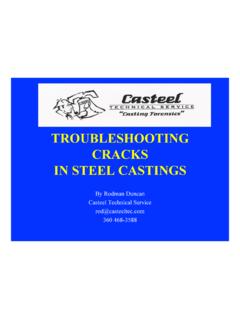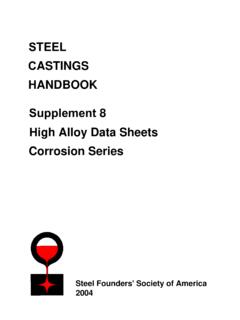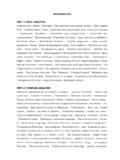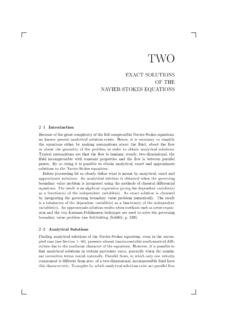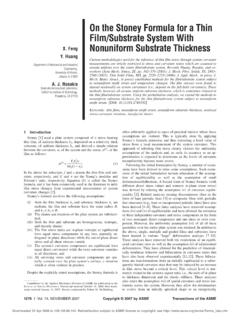Transcription of FRACTURE TOUGHNESS IN RELATION TO STEEL CASTINGS …
1 FRACTURE TOUGHNESS IN RELATION TO STEEL CASTINGS design AND APPLICATION by W. J . Jackson TABLE OF CONTENTS ABSTRACT INTRODUCTION FACTORS OF SAFETY AND BRITTLE FRACTURE FRACTURE MECHANICS Calculation of Critical Flaw Size Subcritical Flaw Growth by Fatigue and Stress Corrosion APPLICATION OF FRACTURE MECHANICS design Material Selection Significance of Discontinuities Monitoring, Control and Failure Analysis Accuracy of Flaw Size Measurement METALLURGICAL FACTORS AFFECTING FRACTURE TOUGHNESS ALTERNATIVE DATA ACCEPTABLE FLAW SIZE DETERMINATION OF FLAW SIZE FLAWS IN RELATION TO QUALITY WELDING OF STEEL CASTINGS SPECIFICATIONS CONCLUSIONS ACKNOWLEDGEMENTS REFERENCES APPENDIX 1 - SAMPLE CALCULATION WRITTEN DISCUSSION AUTHOR'S REPLY Page 1 1 1 3 5 7 10 10 13 14 16 19 20 26 27 29 29 32 34 34 35 36 39 43 43 Dr.
2 W. J. Jackson was born in England and attended Queen Mary's school, Walsall, in Staffordshire, which had its origins over 400 years ago. After wartime service in the Royal Air Force, he went to Birmingham University, where he graduated in Industrial Metallurgy in 1950. He was awarded the degree of (Eng) in Physical Metallurgy at London University in 1953. For two years he worked on and M. I. G. welding in the R & D Department of the British Oxygen Company Ltd., London. He later joined the International Nickel Co. Ltd., in Birmingham as technical assistant in the hot rolling mill. In 1954, he joined in Sheffield, was appointed Head of the Physical Metallurgy Section in 1956, Head of Metallurgy and steelmaking Section in 1963, and to his present position, Research Manager (Product Technology) in 1974.
3 In 1971, he was awarded the degree of for research on high strength STEEL CASTINGS . He is a Fellow of the Institution of Metallurgists and a Fellow of the Royal Institute of Chemistry in London. Dr. Jackson's current research activities are in the field of casting properties, particularly fatigue and FRACTURE TOUGHNESS , heat treatment and transformations, residual elements, welding, elevated temperature properties, surface coating, sizing of defects, ultrasonic techniques and STEEL CASTINGS specifications. FRACTURE TOUGHNESS in RELATION to STEEL CASTINGS design and Application by W. J. Jackson ABSTRACT The purpose of this paper is to demonstrate the value of FRACTURE mechanics in STEEL casting design and material selection, and to point out the significance of defects, especially with regard to brittle FRACTURE and fatigue crack growth.
4 While it has been necessary to include some background theory and mathematical concepts, these have been kept to a minimum; em- phasis is placed on the practical use of FRACTURE TOUGHNESS criteria for establishing safety levels for particular service applications and on the implications of the FRACTURE mechanics approach for the STEEL founder. INTRODUCTION CASTINGS are individual products; they are inspected individually for discontinuities which must be repaired or the casting rejected. In many engineering applications CASTINGS tend to be "over designed", i .e. the safety factors are unnecessarily generous where it can be shown that any defects present are not critical. design rules, to avoid the possibility of fast FRACTURE , are not the only constraints on total CASTINGS design , but they are often the greatest constraint and the least quantitative.
5 A successful FRACTURE mechanics approach to design would encourage production of CASTINGS of better fitness for purpose, and generally lighter section, if this were desirable for other than safety reasons. FACTORS OF SAFETY AND BRITTLE FRACTURE Traditionally, design calculations are based on the theory of elas- ticity, and therefore utilize standard formulae, which assume that the material is elastic, homogeneous and isotropic. For non-critical components, it is usually sufficient to base the design on average stresses, but with critical components it may be necessary to take account of severe stress service conditions, and obtain the local stress distributions by theoret- ical or experimental stress analysis techniques.
6 The design stress is related to either the yield stress, or the , by means of a factor of safety. This single factor which is usually a product of several contrib- utory factors, accounts for local stress fluctuations, variations of service loading conditions, scatter in material properties and environmental effects. The choice of the factor of safety depends on the experience and judgement of the designer unless it is implicitly stated in a relevant specification or design code. For ductile materials and static loading conditions, the factor is related to the yield of proof stress. may usually be ignored, because they are relieved by plastic deformation. The minimum safety factor for STEEL CASTINGS based on the is usually taken as 4, but design engineers, uncertain of the quality of the STEEL and unfamiliar with the reliability of STEEL CASTINGS , have in the past used additional safety factors of 2 to 5 or more.
7 Safety factors are rendered largely unnecessary by the wide range of non- destructive tests which can be applied to STEEL CASTINGS and by the data Local stress concentrations These exaggerated -1- now available, even ignoring recent FRACTURE TOUGHNESS data. This is re- flected in the magnitude of the quality factors applied to STEEL CASTINGS to modify the safety factors for boilers and pressure vessels. The essence of the FRACTURE TOUGHNESS approach is to quantify an ac- ceptable degree of unsoundness in a STEEL casting for a given application and not to attempt to agree on what constitutes complete soundness. A FRACTURE TOUGHNESS approach offers the possibility of distinguishing the ability to resist fast FRACTURE from other constraints such as plastic collapse and, sometimes, buckling.
8 Not all ductile failures involve FRACTURE . The ductile failure is predictable because the necessary load required for a ductile FRACTURE can be calculated or estimated. From a macroscopic viewpoint, a ductile FRACTURE exhibits the following characteristics: a) a large amount of plastic deformation precedes the FRACTURE b) shear lips may be present; c) the FRACTURE may appear to be fibrous, or have a matte or silky texture; e) the cross section at the FRACTURE may be reduced by necking; and crack growth will be slow. Brittle failures cannot be predicted by simple engineering calculations. Because of their catastrophic and unexpected nature, much research has been done in trying to control this problem.
9 From a macroscopic standpoint, brittle fractures are characterized by the following: a) little or no plastic deformation precedes the FRACTURE ; b) the FRACTURE is generally flat and perpendicular to the surface of the component; c) the FRACTURE may appear granular or crystalline and is often highly reflective to light. Facets may also be observed, especially in coarse-grained steels; and propagate rapidly. d) herringbone, or chevron, patterns may be present and cracks When notched, mild STEEL can be made to FRACTURE in either a brittle or a ductile manner merely by altering the temperature. Even if a notch is not made deliberately, a small crack can be initiated within a metal, as in the case of a polished fatigue specimen, by a process of grain boundary movement or slip.
10 Cracks are also initiated at elevated temperatures when a STEEL is under creep conditions. Such cracks may be very small but will have extremely sharp extremities. With steels generally, initiation of brittle FRACTURE is more difficult than propagation, given the same operating conditions. Most structures, such as bridges, ships, storage tanks, pressure vessels, are designed on the basis of defect-free materials, with appropriate factors of safety based mainly on past experience. By applying FRACTURE mechanics a more realistic approach can be made, accepting that no metal is defect-free and calculating the size of defect that can be tolerated without it propagating in a brittle manner. The TOUGHNESS of the STEEL obviously influences the propagation or arrest of a crack and in practice the problem is one of defining TOUGHNESS , deciding by which tests it should be assessed and what level should be specified.

